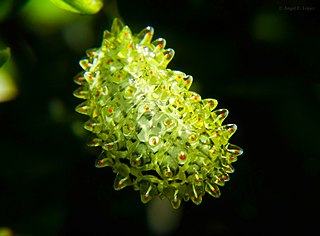Dalcerina tijucana is a moth in the family Dalceridae, and the only species in the genus Dalcerina. It was described by Schaus in 1892. It is found in Panama, eastern Peru, Brazil, Paraguay and northern Argentina. The habitat consists of tropical wet, tropical moist, tropical premontane moist, subtropical wet, subtropical moist, subtropical dry, subtropical lower montane moist and warm temperate moist forests.
Acraga luteola is a moth of the family Dalceridae. It is found in northern Brazil. The habitat probably consists of tropical moist forests.
Acraga hamata is a moth of the family Dalceridae. It is found in Costa Rica, Panama and possibly Colombia. The habitat consists of tropical premontane wet and rain forests at altitudes above 800 meters.

Acraga coa is a moth of the family Dalceridae. It is found in southern Mexico, Belize, Honduras, Guatemala, El Salvador, Costa Rica and Panama. The habitat consists of tropical wet, tropical moist, tropical premontane wet, tropical premontane rain, tropical lower montane moist, subtropical wet, subtropical moist, subtropical dry and warm temperate wet forests.
Acraga concolor is a moth from the family Dalceridae. It is found in Venezuela, Surinam, French Guiana, northern Brazil, Ecuador, Peru and Bolivia. The habitat consists of tropical moist, tropical wet, tropical premontane rain, tropical premontane wet and subtropical moist forests.
Acraga beebei is a moth of the family Dalceridae. It is found in northern Venezuela. The habitat consists of tropical premontane moist forests.
Acraga melinda is a moth of the family Dalceridae first described by Herbert Druce in 1898. It is found in Costa Rica and Panama. The habitat consists of tropical premontane wet and rain forests where it is found at altitudes above 600 meters.
Acraga citrina is a moth of the family Dalceridae. It is found in Trinidad, Venezuela, Guyana, Surinam, French Guiana and northern Brazil. The habitat consists of tropical moist, tropical dry, tropical premontane moist and tropical premontane dry forests.
Acraga angulifera is a moth in the family Dalceridae. It was described by Schaus in 1905. It is found in Trinidad, Venezuela, Surinam and French Guiana. The habitat consists of tropical moist forests.
Acraga leberna is a moth in the family Dalceridae. It was described by Druce in 1890. It is found in Panama, Colombia, Venezuela, Guyana, Surinam, French Guiana, Ecuador, northern Brazil, Peru and Bolivia. The habitat consists of tropical wet, tropical moist and tropical premontane wet forests.
Acraga conda is a moth in the family Dalceridae. It was described by Harrison Gray Dyar Jr. in 1911. It is found in the Guianas.
Dalcerides mesoa is a moth in the family Dalceridae. It was described by Herbert Druce in 1887. It is found in southern Mexico, Guatemala, Costa Rica, Panama, Colombia, Venezuela and Ecuador. The habitat consists of tropical wet, tropical moist, tropical dry, tropical premontane wet, tropical premontane rain, subtropical wet and subtropical dry forests.
Dalcerides nana is a moth in the family Dalceridae. It was described by Paul Dognin in 1920. It is found in southern Brazil. The habitat consists of subtropical wet and subtropical moist forests.
Dalcerides rebella is a moth in the family Dalceridae. It was described by Schaus in 1911. It is found in Costa Rica and Ecuador. The habitat consists of tropical wet and premontane wet forests.
Dalcerides chirma is a moth in the family Dalceridae. It was described by Schaus in 1920. It is found in southern Mexico and Guatemala. The habitat consists of tropical moist and subtropical wet forests.
Dalcerides flavetta is a moth in the family Dalceridae. It was described by Schaus in 1905. It is found in Venezuela, Guyana, Surinam, French Guiana, Colombia, Ecuador, Peru, Bolivia and northern Brazil. The habitat consists of tropical wet, tropical moist, tropical premontane wet, tropical premontane moist, subtropical moist and tropical dry forests.
Ca anastigma is a moth in the family Dalceridae. It was described by Harrison Gray Dyar Jr. in 1914. It is found in Panama. The habitat consists of tropical moist forests.
Minacragides arnacis is a moth in the family Dalceridae. It was described by Harrison Gray Dyar Jr. in 1909. It is found in Colombia, Venezuela, Guyana, Suriname and Peru. The habitat consists of tropical moist, tropical premontane wet and tropical premontane moist forests.
Minonoa elvira is a moth in the family Dalceridae. It was described by Paul Dognin in 1909. It is found in Colombia. The habitat consists of tropical lower montane and premontane wet forests.
Dalcerides radians is a moth in the family Dalceridae. It was described by Walter Hopp in 1921. It is found in southern Brazil. The habitat consists of subtropical wet, subtropical moist and warm temperate moist forests.
